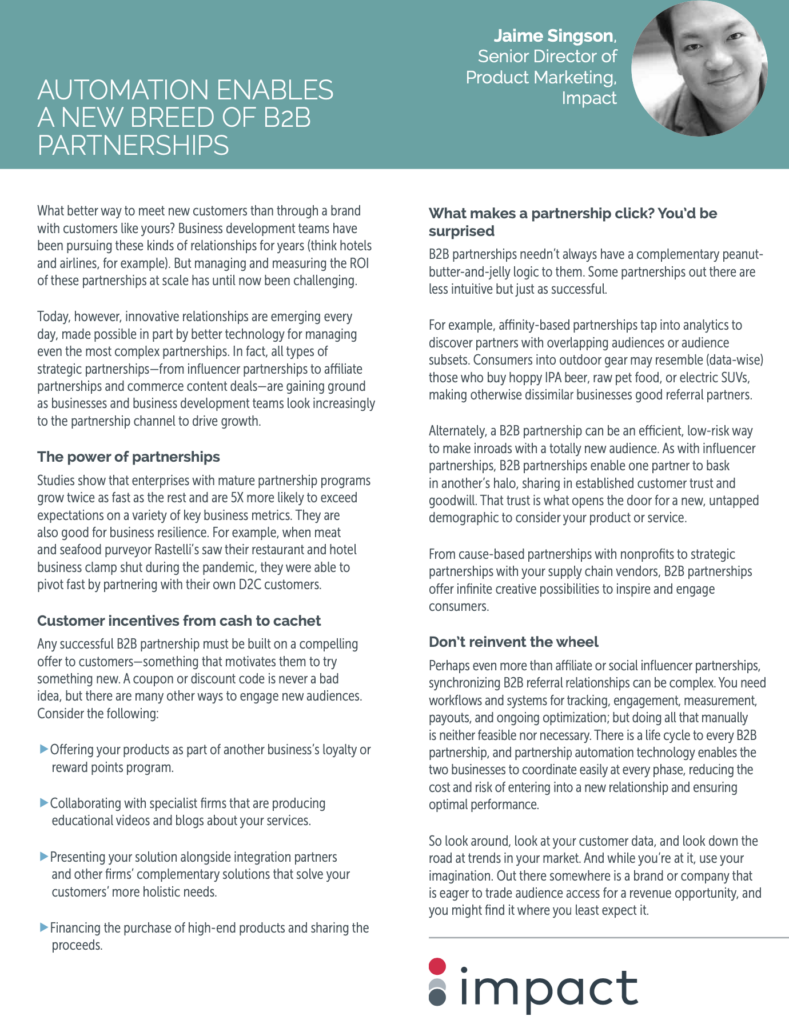
By Jaime Singson, Senior Director of Product Marketing, Impact.
Originally published on Internet Retailer.
What better way to meet new customers than through a brand with customers like yours? Business development teams have been pursuing these kinds of relationships for years (think hotels and airlines, for example). But managing and measuring the ROI of these partnerships at scale has until now been challenging.
Today, however, innovative relationships are emerging every day, made possible in part by better technology for managing even the most complex partnerships. In fact, all types of strategic partnerships — from influencer partnerships to affiliate partnerships and commerce content deals — are gaining ground as businesses and business development teams look increasingly to the partnership channel to drive growth.
The power of partnerships
Studies show that enterprises with mature partnership programs grow twice as fast as the rest and are 5X more likely to exceed expectations on a variety of key business metrics. They are also good for business resilience. For example, when meat and seafood purveyor Rastelli’s saw their restaurant and hotel business clamp shut during the pandemic, they were able to pivot fast by partnering with their own D2C customers.
Customer incentives from cash to cachet
Any successful B2B partnership must be built on a compelling offer to customers — something that motivates them to try something new. A coupon or discount code is never a bad idea, but there are many other ways to engage new audiences. Consider the following:
- Offering your products as part of another business’ loyalty or reward points program
- Collaborating with specialist firms that are producing educational videos and blogs about your services
- Presenting your solution alongside integration partners and other firms’ complementary solutions that solve your customers’ more holistic needs.
- Financing the purchase of high-end products and sharing the proceeds
What makes a partnership click? You’d be surprised
B2B partnerships needn’t always have a complementary peanut-butter-and-jelly logic to them. Some partnerships out there are less intuitive but just as successful.
For example, affinity-based partnerships tap into analytics to discover partners with overlapping audiences or audience subsets. Consumers into outdoor gear may resemble (data-wise) those who buy hoppy IPA, raw pet food, or electric SUVs, making otherwise dissimilar businesses good referral partners.
Alternately, a B2B partnership can be an efficient, low-risk way to make inroads with a totally new audience. As with influencer partnerships, B2B partnerships enable one partner to bask in another’s halo, sharing in established customer trust and goodwill. That trust is what opens the door for a new, untapped demographic to consider your product or service.
From cause-based partnerships with nonprofits to strategic partnerships with your supply chain vendors, B2B partnerships offer infinite creative possibilities to inspire and engage consumers.

Don’t reinvent the wheel
Perhaps even more than affiliate or social influencer partnerships, synchronizing B2B referral relationships can be complex. You need workflows and systems for tracking, engagement, measurement, payouts, and ongoing optimization; but doing all that manually is neither feasible nor necessary. There is a life cycle to every B2B partnership, and partnership automation technology enables the two businesses to coordinate easily at every phase, reducing the cost and risk of entering into a new relationship and ensuring optimal performance.
So look around, look at your customer data, and look down the road at trends in your market. And while you’re at it, use your imagination. Out there somewhere is a brand or company that is eager to trade audience access for a revenue opportunity, and you might find it where you least expect it.
Want to explore B2B partnerships more? Contact an Impact growth technologist at grow@impact.com.




